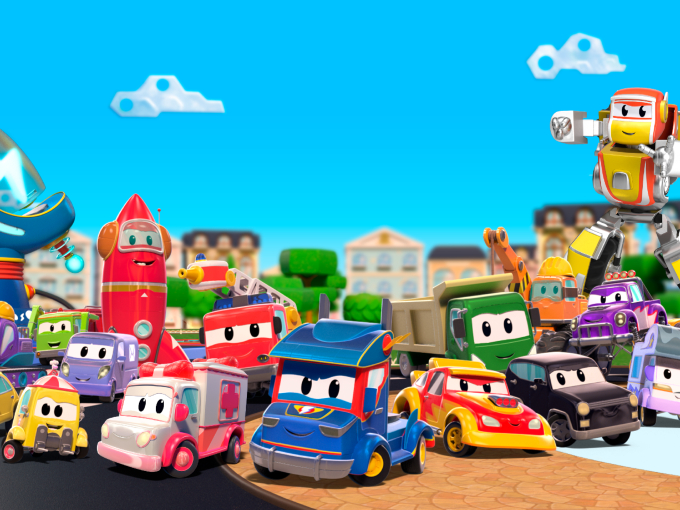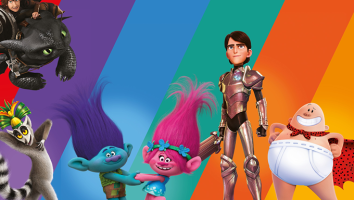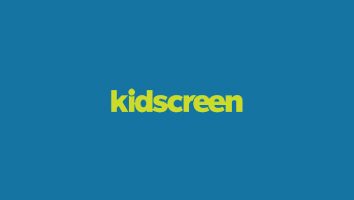So you’ve conquered YouTube…now what? If you’re digital-first studio Amuse Animation, you set a new course for 360-degree growth by readying key properties for premium iteration and global franchise success.
After self-funding a whopping 30-plus original preschool properties on YouTube that have generated billions of views since 2016, the Canary Islands-based studio has cherry-picked three CG-animated series from its portfolio that show the most potential for growth, based on years of data collection from YouTube.
The first is Car City (pictured), a comedy-adventure series about friendly anthropomorphic vehicles with careers ranging from superhero to inventor. “It was one of our first IPs and was made on a very low budget,” says founder Arthur Lener. “Now, it and its 13 spinoffs have collectively generated 24 billion views across platforms.”
Next up is Animacars—another vehicle-inspired series, but with more of an action-adventure feel. After inventing five hybrids with names like Tigears and Wheelephant, the show’s kid heroes form a rescue team to keep their town safe.
“It’s a successful YouTube-first series that has attracted the eyes of several broadcasters in the past, but at the time we weren’t at the level to push it further,” says Lener. “Now, after examining what worked or didn’t, we have a new value proposition that we feel is very complete in terms of audience and toyetic potential.”
The studio’s third spotlight series is Increditales, a comedy-edutainment sketch show where classic fairytale characters like Snow White and Cinderella live together and are thrust into situations by the series’ narrator, a little girl with a vivid imagination. “There is a lot of depth to the world of the show that is still unexplored, with many opportunities for diverse, cross-cultural characters,” notes Lener.
Amuse recently presented new-andimproved (in terms of animation quality and writing) versions of all three shows to broadcast and streaming buyers at Annecy, and will showcase them again at MIPCOM in October. The studio is eyeing exclusive and non-exclusive deals, depending on the project and buyer. Outside of Europe, it also sees new audience growth potential in North and South America, Africa and Asia—Amuse recently opened an office in Beijing, headed by distribution, co-production and licensing executive Entin Liu.

Amuse sees unexplored potential in its comedy-edutainment sketch show Increditales.
According to chief revenue officer Jiella Esmat, the timing for growth could not be better, for a number of reasons.
First, Esmat acknowledges the success of CoComelon producer Moonbug Entertainment for opening minds about what can be done with animated YouTube content. “Moonbug has done an amazing job of demonstrating how content can be taken from YouTube and spread globally,” she says. “It has changed people’s perceptions, so the timing is perfect in that sense, and we’re seeing a lot of YouTube content creators following that strategy now and having great success.”
Interestingly, Esmat joined Amuse’s London office last October after serving as Moonbug’s senior director of distribution and content partnerships. Her remit now is to drive 360-degree growth for Amuse, while also developing co-production partnerships and scouting for third-party service work. On the service front, the studio has partnered on global hit series including Molang, Louis and Tulipop, as well as new projects such as Odd-Paw Vet, Hasbro/eOne’s first-ever digital-led preschool series.
Esmat and Lener stress that the studio has now reached a mature phase—delivering on its initial strategy of building a portfolio of proof-of-concept, cost-efficient shows that allow for quick iterations, ROI and greater visibility. (Amuse has fully funded its own IPs from service work revenue and performance-based revenue sharing from its distribution partners, including YouTube, Amazon, Tencent, Youku and iQiyi.)
The studio is also at a place, both artistically and financially, where it can now offer premium and high-premium projects along with digital-first series.
Lener defines digital-first as self-financed, low-budget, 2D- or CG-animated shows for YouTube. “These feature very simple narratives and allow us to iterate a lot by testing things like story themes and character designs,” he says. “For this type of series, episode 25 will often look completely different from episode one, but that’s OK because it’s all about producing one episode at a time to find your market fit.”
Lener sees premium as high-quality, mid-budget content that is self-financed or co-financed with toy partners. “It is standard TV quality, but it also works for all platforms, including YouTube and Netflix,” he says. “We’re really pushing for this type of content now, but also trying to limit unnecessary costs. A lot of series do too much [in terms of animation quality], so the costs end up being very high, but the performance doesn’t necessarily reflect that.”
As for high-premium shows, Lener describes these as bigger-budget series that Amuse would co-finance with a platform. “These are your typical Netflix or WBD animated series where we would be less concerned about budget because we would co-finance with a platform,” he says.
Looking at the macro-economic climate, Esmat notes that many companies are reducing costs and realizing that preschoolers don’t need to see every strand of hair in animation. “The whole industry is waking up to the fact that you don’t need to spend as much on animation,” she says. “Those superhigh US$10-million to US$20-million premium animated projects will become fewer and fewer over time.”
Some of the ways in which Amuse aims to reduce costs and manage its workflow speed include the potential use of 2D VFX instead of 3D in certain instances where the results are negligible to a preschooler; minimizing grooming for animated hair, fur and detailed grass; avoiding action in water, rain and snow scenes, and also reflections on mirrors and glass, if possible; limiting sky range/expansive sky shots and retaining a lower-level vantage point for any scenes that may have planes flying overhead, for example; reusing as many [animated] props as possible without compromising the story/show; and fast 24- to 48-hour approval turnarounds on assets, both internally for Amuse IPs and from clients on production services.
The fact that Amuse’s development and production hub for 2D and CG animation, audio content and gaming apps is located in Las Palmas de Gran Canaria, which offers a tax rebate of up to 54% for international productions, also makes it an ideal partner for service work, says Lener. (Additionally, the Canary Islands have a 4% corporate tax rate, and sales tax is only 7%, with a 0% tax for certain categories related to audiovisual production.)
“Tax credits were obviously a key reason for us to move to the Canaries,” says Lener. “Our offices in London and China are more about finding key local co-pro partners.”
Meanwhile, Amuse’s Paris office mainly manages distribution, co-productions and consumer products. Along with linear, platform and L&M growth, Esmat says conversations are also underway with theatrical companies looking to fill dead space. “Animation is a great pull for parents who are looking to fill time for preschoolers, and preschool content lends itself really well in certain theatrical environments.”
Looking forward, Esmat and Lener agree that the studio’s biggest challenge will be convincing strategic partners to sign on to new original IPs.
“There are so many big content owners out there that when you are one of the smaller new ones on the block, getting the majors to take you seriously can be a bit of a challenge,” says Esmat. “But we are working hard to build a strong story so that the Netflixes of the world will sit at the table with us.”
For Lener, the industry is changing to the point where there is a massive gap in the market. “There is perhaps much more space than before to create the next big global license if you have the right strategy, content and execution. It is a very new audience-centric world where the potential is amazing.”
This story originally appeared in Kidscreen’s August/September 2023 issue.



























